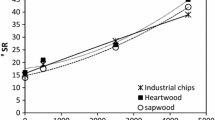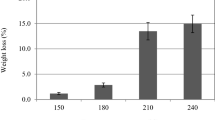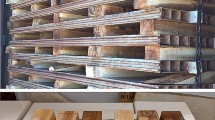Abstract
The physical properties and morphology of kraft paper handsheets obtained from tension wood of intensively managed, 5-year-old trees of Populus “Tristis No. 1” were compared to those produced from isolated normal wood of the same stems. Pulp yields of tension wood (TW) and normal wood (NW) were 60 and 53% respectively. Over a beating range of 0–45 minutes, strength properties of TW paper were in all cases noticeably inferior to those obtained from NW. During paper formation, the TW or gelatinous fibers resisted collapse, even upon extended refining, and produced thick, porous sheets of poorly bonded elements. It was concluded that the differential behavior of NW and TW pulps was in several respects analogous to those displayed by earlywood and latewood pulps, respectively, of softwood species as well as thin-vs. thick-walled hardwood fibers. Consequently, it appears that the inferior strength of TW paper is primarily a function of fiber morphology, and the difference in hemicellulose content between NW and TW (viz., lower pentosan content of TW) often cited in the literature as a potential major factor here probably contributes little if any significant effect on ultimate interfiber bonding and paper quality.
Similar content being viewed by others
References
Anderson, H. W., Zsuffa, L. 1975. Yield and wood quality of hybrid cottonwood grown in two-year rotation. Forest Res. Rept. No. 101. Maple, Ontario: Ont. Min. Nat. Resources, Div. Forests
Barker, R. G. 1974. Papermaking properties of young hardwoods. Tappi 57 (8): 107–111
Berlyn, G. P. 1961. Factors affecting the incidence of reaction tissue in Populus deltoides Bartr. Iowa State J. Sci. 35 (3): 367–424
Borchardt, L. G., Piper, C. V. 1970. A gas chromatographic method for carbohydrates as alditolacetates. Tappi 55 (2): 256–260
Clermont, L., Bender, F. 1958. The chemical composition and pulping characteristics of normal and tension wood of aspen poplar and white elm. Pulp Paper Mag. Can. 59: 139–143
Correns, E. 1961. On abnormal wood fibers. Paperi ja Puu 43 (2): 47–62
Côté, W. A., Day, A. C., Timell, T. E. 1969. A contribution to the ultrastructure of tension wood fibers. Wood Sci. Technol. 3: 257–271
Cram, W. H. 1960. Performance of 17 poplar clones in south central Saskatchewan. For. Chron. 36 (3): 204–208
Crist, J. B., Dawson, D. H. 1975. Anatomy and dry weight yields of two Populus clones grown under intensive culture. USDA For. Ser. Res. Paper, NC-113. North Central For. Exp. Stn., St. Paul, MN.
Dadswell, H. E., Wardrop, A. B., Watson, A. J. 1958. The morphology, chemistry and pulping characteristics of reaction wood. In: Bolam, F. (Ed.): Fundamental of papermaking fibers. London: Technical Section BPPMA, 187–219
Dawson, D. H., Hutchinson, J. 1972. Research tackles pulpwood generation gap through maximum fiber yield program. For. Indust. 26/27: 17–18
Dinwoodie, J. M. 1968. Failure in timber. Part I. Microscopic changes in cell-wall structure associated with compressive failure. J. Inst. Wood Sci. 4 (3): 37–53
Einspahr, D. W. 1976. The influence of short-rotation forestry on pulp and paper quality. I. Short-rotation conifers. II. Short-rotation hardwoods. Tappi (in press)
Gardner, H. S., Einspahr, D. W. 1964. Reproducibility of micropulping wood samples. Tappi 47 (7): 432–434
Hughes, F. E. 1965. Tension wood. A review of literature. For. Abstr. 26: 2–9, 179–186
Ilvessalo-Pfaffli, M. S., Alfthan, G. V. 1957. The measurement of fiber length with a semiautomatic recorder. Paperi ja Puu 39 (11): 509–516
Isebrands, J. G., Bensend, D. W. 1972. Incidence and structure of gelatinous fibers within rapid-growing eastern cottonwood. Wood Fiber 4 (2): 61–71
Isebrands, J. G., Parham, R. A. 1974. Tension wood anatomy of short-rotation Populus spp. before and after kraft pulping. Wood Sci. 6 (3): 256–265
Jayme, G. 1951. The significance of tension wood content in poplar wood. Holz Roh-Werkstoff 9 (5): 173–175
Jayme, G., Harders-Steinhauser, M., Mohrberg, W. 1951. The influence of percentage of tension wood upon the technological and chemical suitability of poplar woods. Papier 5: 411–417, 445–447, 504–507
Kaeiser, M. 1955. Frequency and distribution of gelatinous fibers in eastern cottonwood. Amer. J. Bot. 42 (3): 331–336
Kearp, J. L. 1975. Projection of world demand and supply for wood fiber to the year 2000. Tappi 58 (11): 90–95
Klauditz, W. 1962. The cellulose content of the wood of hybrid poplars in relation to pulp and paper manufacture. Papier 16: 463–477
Krempl, H. 1975. Differences in tension wood content in various poplar species. Holzforsch. Holzverwert. 27 (6): 131–136
Obermans, H. E. 1936. A study of the effect of hemicelluloses on the beating and strength of pulps. Paper Trade J., Tappi Sect. 103 (7): 83–91
Parham, R. A. 1975. Critical-point drying for fiber microscopy. Tappi 58 (3): 138–140
Ribe, J. H. 1974. Will short-rotation forestry supply future pulpwood néeds? Pulp Paper 48 (12): 72–75
Schroeder, H. A. 1976. Chemical pulp from hardwoods native to the South-Review of techniques, properties, and markets. Forest Prod. J. 26 (1): 34–39
Scurfield, G. 1973. Reaction wood: Its structure and function. Science 179 (4074): 647–655
Thode, E., Peckham, J., Daleski, B. 1961. An evaluation of certain laboratory pulping methods. Tappi 44 (2): 81–88
Timell, T. E. 1969. The chemical composition of tension wood. Svensk Papperstidn. 72 (6): 173–181
Wardrop, A. B. 1963. Morphological factors involved in the pulping and beating of wood fibers. Svensk Papperstid. 66 (7): 231–247
Watson, A. J. 1956. Pulping characteristics of eucalypt tension wood. Proc. APPITA 10: 43–59
Watson, A. J., Dadswell, H. E. 1962. Influence of fiber morphology on paper properties. Part II. Early wood and late wood. APPITA 15 (6): 116–128
White, D. J. B., Robards, A. W. 1965. Gelatinous fibers in ash (Fraxinus excelsior L.). Nature 205: 818
Author information
Authors and Affiliations
Additional information
The experimental phase of this investigation was carried out by K. W. Robinson in partial fulfillment of the requirements of The Institute of Paper Chemistry for the M.S. degree from Lawrence University, Appleton, Wisconsin.
Rights and permissions
About this article
Cite this article
Parham, R.A., Robinson, K.W. & Isebrands, J.G. Effects of tension wood on kraft paper from a short-rotation hardwood (Populus “Tristis No. 1”). Wood Sci. Technol. 11, 291–303 (1977). https://doi.org/10.1007/BF00356927
Received:
Issue Date:
DOI: https://doi.org/10.1007/BF00356927




